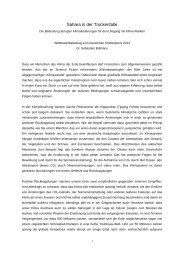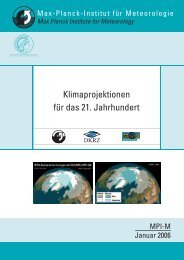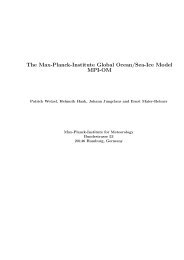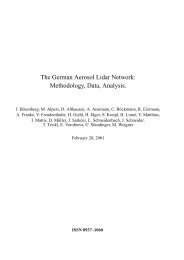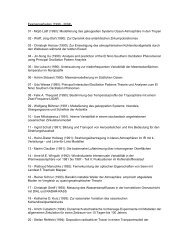Berichte zur Erdsystemforschung - Max-Planck-Institut für ...
Berichte zur Erdsystemforschung - Max-Planck-Institut für ...
Berichte zur Erdsystemforschung - Max-Planck-Institut für ...
You also want an ePaper? Increase the reach of your titles
YUMPU automatically turns print PDFs into web optimized ePapers that Google loves.
Intertropical Convergence Zone (ITCZ). In contrast, the East Asian summer monsoon is<br />
controlled by the monsoon trough on the Asian continent and the western Pacific<br />
subtropical high. It is, therefore, characterised by a zonal pressure-gradient and has to be<br />
seen in association with the Walker Circulation (Webster et al., 1998). As a result of the<br />
east-west thermal contrast, a planetary subtropical front is formed (Meiyu-Baiu frontal<br />
system) whose seasonal march determines the propagation of the East Asian summer<br />
monsoon rainbelt (e.g. Ding, 2007). The subtropical front is separated from the ITCZ,<br />
which forms a second rainband in East Asia (tropical rainbelt) affecting mainly the western<br />
North Pacific monsoon.<br />
According to Ding and Chang (2005), Ding (2007) and He et al. (2007), the summer<br />
monsoon season first starts in the equatorial East Indian Ocean and Sumatra in late April.<br />
In a second stage beginning early to mid of May, the monsoon expands to the Bay of<br />
Bengal, southern Indochina and the South China Sea. From these regions, two branches<br />
move north-west- and north-eastward to South China (mid and late May) and the Indian<br />
subcontinent (early to mid June) establishing the onset of the East Asian and the Indian<br />
summer monsoon, respectively. The Indian monsoon then penetrates further inland<br />
arriving in Northwest India in the mid of July. The East Asian monsoon moves northward<br />
in a stepwise manner that is characterised by abrupt jumps from one region to another. In<br />
early June, it arrives in the Yangtze River valley and Japan bringing the so called Meiyu<br />
and Baiu rain, respectively. It then jumps to Northeast China and the Korean Peninsula<br />
(Changma rainy season) in early and mid-July where it stays until the end of August or<br />
early September before it starts to continuously move back to the South China Sea. The<br />
Indian monsoon terminates not until late September.<br />
The East Asian monsoon system differs from the Indian monsoon also in other respects.<br />
The interplay of the mid-latitude westerlies, the subtropical circulation around the western<br />
Pacific subtropical high and the tropical circulation including the Indian monsoon flow<br />
makes the East Asian monsoon domain unique and enables the occurrence of many<br />
significant weather and climate phenomena (Ding, 2007). In contrast to other monsoon<br />
regions, the precipitation in the East Asian monsoon domain is not temporally confined to<br />
the summer monsoon season. The wintertime pressure-gradient between the Siberian high<br />
and the Aleutian low induces cold northerly winds embedding regularly cold-air outbreaks<br />
(Wang B., 2006) in the entire East Asian monsoon region. Therefore, the East Asian<br />
monsoon domain is not characterised by the alternation of wet and dry seasons but rather<br />
by the alternation of particularly wet and cold seasons.<br />
Recent studies have shown that climate models reveal large deficits in representing the<br />
mean precipitation distribution, the season cycle and the interannual variability of the<br />
Asian monsoon system (Kang et al. 2002; Zhou et al., 2009; Boo et al., 2011). In contrast,<br />
the temperature distribution and monsoon circulation can be captured by the models.<br />
8




